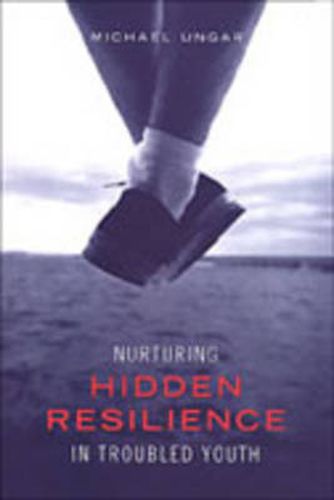Readings Newsletter
Become a Readings Member to make your shopping experience even easier.
Sign in or sign up for free!
You’re not far away from qualifying for FREE standard shipping within Australia
You’ve qualified for FREE standard shipping within Australia
The cart is loading…






Michael Ungar’s Nurturing Hidden Resilience in Troubled Youth is the first text in its field to examine resilience as a social construct; it offers a comprehensive theory of resilience and a model for the application of this theory to direct practice with high-risk youth in clinical, residential, and community settings.
Ungar’s analysis of resilience and approach to intervention focuses on the unique group of youth who are labeled dangerous, deviant, delinquent, and disordered. He explores how these youth discover and maintain well-being through discursive empowerment: using detailed case studies, Ungar finds that high-risk youth explain their problematic behaviours, such as gang affiliations and drug and alcohol use, as strategic ways to compose healthy stories about themselves that bring them experiences of control and acceptance. Unlike most extant literature on risk and resiliency, Ungar’s text provides a novel and fresh approach to the resiliency construct and, perhaps more importantly, gives voice to the adolescents themselves.
Timely in subject and original in perspective, Nurturing Hidden Resilience in Troubled Youth challenges what popular media refer to as a ‘youth problem.’ Ungar offers an alternative approach to troubled youth and suggests that we build upon, rather than resist, their constructions of resilience as a method of effective intervention.
$9.00 standard shipping within Australia
FREE standard shipping within Australia for orders over $100.00
Express & International shipping calculated at checkout
Michael Ungar’s Nurturing Hidden Resilience in Troubled Youth is the first text in its field to examine resilience as a social construct; it offers a comprehensive theory of resilience and a model for the application of this theory to direct practice with high-risk youth in clinical, residential, and community settings.
Ungar’s analysis of resilience and approach to intervention focuses on the unique group of youth who are labeled dangerous, deviant, delinquent, and disordered. He explores how these youth discover and maintain well-being through discursive empowerment: using detailed case studies, Ungar finds that high-risk youth explain their problematic behaviours, such as gang affiliations and drug and alcohol use, as strategic ways to compose healthy stories about themselves that bring them experiences of control and acceptance. Unlike most extant literature on risk and resiliency, Ungar’s text provides a novel and fresh approach to the resiliency construct and, perhaps more importantly, gives voice to the adolescents themselves.
Timely in subject and original in perspective, Nurturing Hidden Resilience in Troubled Youth challenges what popular media refer to as a ‘youth problem.’ Ungar offers an alternative approach to troubled youth and suggests that we build upon, rather than resist, their constructions of resilience as a method of effective intervention.